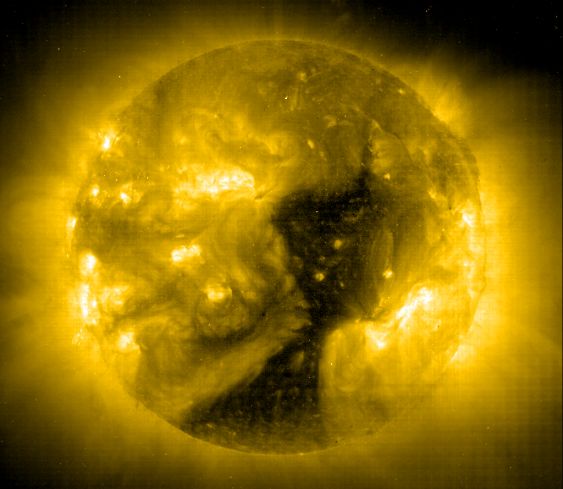Explanation: This ominous, dark shape sprawling across the face of the active Sun is a coronal hole -- a low density region extending above the surface where the solar magnetic field opens freely into interplanetary space. Studied extensively from space since the 1960s in ultraviolet and x-ray light, coronal holes are known to be the source of the high-speed solar wind, atoms and electrons which flow outward along the open magnetic field lines. During periods of low activity, coronal holes typically cover regions just above the Sun's poles. But this coronal hole, one of the largest seen so far in the current solar activity cycle, extends from the south pole (bottom) well into northern hemisphere. Coronal holes like this one may last for a few solar rotations before the magnetic fields shift and change configurations. Shown in false-color, this picture of the Sun on January 8th was made in extreme ultraviolet light by the EIT instrument on board the space-based SOHO observatory.
1999 2000 2001 2002 2003 2004 2005 2006 2007 2008 2009 2010 2011 2012 2013 2014 2015 2016 2017 2018 2019 2020 2021 2022 2023 2024 2025 |
Январь Февраль Март Апрель Май Июнь Июль Август Сентябрь Октябрь Ноябрь Декабрь |
NASA Web Site Statements, Warnings, and Disclaimers
NASA Official: Jay Norris. Specific rights apply.
A service of: LHEA at NASA / GSFC
& Michigan Tech. U.
|
Публикации с ключевыми словами:
corona - coronal hole - Sun - solar wind - Солнце - Солнечная корона - Солнечный ветер
Публикации со словами: corona - coronal hole - Sun - solar wind - Солнце - Солнечная корона - Солнечный ветер | |
См. также:
Все публикации на ту же тему >> | |
